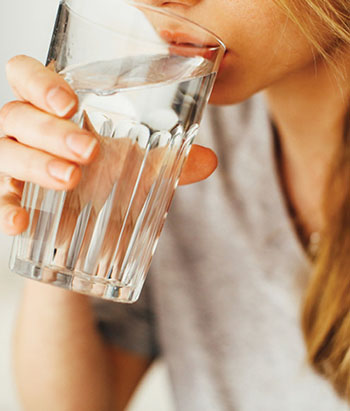Heat Stress- Signs and Prevention
Guide I-115
Sonja Koukel
College of Agricultural, Consumer and Environmental Sciences, New Mexico State University
Professor/Extension Community and Environmental Health Specialist, Department of Extension Family and Consumer Sciences, New Mexico State University. (Print Friendly PDF)
Sweating cools the body. When you don’t sweat, your body temperature can rise to dangerous levels. Getting too hot can make you sick. This is known as heat stress. This guide discusses types of heat stress and ways you can protect yourself from getting sick.
Types of Heat Stress
- Dehydration
- Heat exhaustion
- Heat cramps
- Heat syncope
- Heat rash
- Heat stroke
Dehydration occurs when the body loses water and the water is not replaced by drinking fluids or eating foods that contain water. Our bodies get out of balance when too much water is lost. Serious dehydration can lead to death.
Signs of dehydration are:
- Dry mouth
- Feeling very thirsty
- Feeling dizzy or confused
- Not being able to sweat

© Daria Shevtsova | Pexels.com
Heat exhaustion and dehydration often go hand in hand. When you get dehydrated and stay in the heat for a long time, you can get heat exhaustion. Heat exhaustion is most common in the elderly, people who work outdoors, and people with high blood pressure. Some signs of heat exhaustion are:
- Heavy sweating
- Skin feels cold, wet, and sticky
- Muscle cramps (pains)
- Feeling very weak or tired
- Pale skin
- Feeling sick to your stomach (nausea)
- Vomiting (throwing up)
- Very fast heartbeat
Heat cramps are body pains that can happen when you do heavy exercises, activities, or hard work in hot conditions. Dehydration can cause heat cramps. Muscle pain or spasms (sudden, strong muscle tightening or painful twists) in the stomach area, arms, or legs are the most common signs. Heat cramps may also be a sign of heat exhaustion.
Heat syncope is a type of heat illness. A sign of heat syncope is when you are working or playing in the heat and begin to feel dizzy or like you are going to faint.
Heat rash is a group of red pimples or small blisters on the neck and upper chest, underneath breasts, or around the groin area. Too much sweating when you work or play in the heat or in damp, moist weather causes the rash.
Heat stroke is very serious. Heat stroke happens when your body temperature rises very fast, your ability to sweat fails, and you cannot cool down. The normal body temperature is 98.6°F. Heat stroke can cause the body temperature to rise to 106°F or higher in just 10 to 15 minutes. Signs of heat stroke are:
- Confusion
- Chills or feeling cold
- Loss of awareness (consciousness)
- Fits of uncontrolled movements (convulsions)
- Coma (deep unconsciousness over a long time)
- Strong, fast pulse
Prevent Heat Stress
- Drink fluids, such as water and sports drinks, before and while you are working or playing in the heat.
- Wear light-colored, loose-fitting clothing.
- Try to stay out of the sun during the hottest time of the day. This is between 10:00 am and 4:00 pm.
- Go to a cool place when you feel overheated.

© Manop Lohkaew | Dreamstime.com
Resources
Centers for Disease Control and Prevention (CDC). n.d. Heat-related illness. Retrieved from https://www.cdc.gov/pictureofamerica/pdfs/Picture_of_America_Heat-Related_Illness.pdf
Centers for Disease Control and Prevention (CDC). 2018, June 6. Heat stress. Retrieved from https://www.cdc.gov/niosh/topics/heatstress/default.html
Centers for Disease Control and Prevention (CDC). 2018, June 6. Heat stress–Heat related illness. Retrieved from https://www.cdc.gov/niosh/topics/heatstress/heatrelillness.html
Cunha, J.P. 2019. Heat cramps. Retrieved from https://www.emedicinehealth.com/heat_cramps/article_em.htm#facts_and_definition_of_heat_cramps
Korey Stringer Institute, University of Connecticut. n.d. Heat syncope. Retrieved from https://ksi.uconn.edu/emergency-conditions/heat-illnesses/heat-syncope/#
Ludlam, K. 2018, March 29. Types of heat rash. Retrieved from https://www.healthline.com/health/heat-rash-pictures-remedies
Mayo Clinic. 2019, September 19. Dehydration. Retrieved from https://www.mayoclinic.org/diseases-conditions/dehydration/symptoms-causes/syc-20354086
Stöppler, M.C. 2018, May 23. Heat stroke symptoms, signs, first aid, and recovery. Retrieved from https://www.medicinenet.com/heat_stroke/article.htm#can_infants_children_and_teens_suffer_from_heat_stroke
CAUTION:
Heat stroke can cause permanent disability or death. Get emergency medical help immediately.
Call 911.
For Further Reading
I-101: Physical Activity and You (for Adults)
pubs.nmsu.edu/_i/I101/
I-102: West Nile Virus: Information for New Mexico
pubs.nmsu.edu/_i/I102/
I-106: Skin Cancer
pubs.nmsu.edu/_i/I106/

Sonja Koukel is Assistant Professor and Extension Community and Environmental Health Specialist in the Department of Extension Family and Consumer Sciences. She earned her B.S. at NMSU and her M.S. and Ph.D. at Texas Tech University. Her Extension programs focus on health and wellness—physical, mental, spiritual, and environmental.
To find more resources for your business, home, or family, visit the College of Agricultural, Consumer and Environmental Sciences on the World Wide Web at pubs.nmsu.edu.
Contents of publications may be freely reproduced, with an appropriate citation, for educational purposes. All other rights reserved. For permission to use publications for other purposes, contact pubs@nmsu.edu or the authors listed on the publication.
New Mexico State University is an equal opportunity/affirmative action employer and educator. NMSU and the U.S. Department of Agriculture cooperating.
March 2020 Las Cruces, NM


